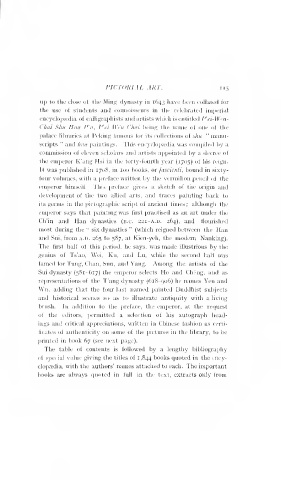Page 369 - Chinese Art, Vol II By Stephen W. Bushell
P. 369
PICTORIAL ART. 115
up to the close ol the Ming dynasty in 1643 have been collated for
the use of students and connoisseurs in the celebrated imperial
encycIopcX'dia of calligraphists and artists which is entitled P'ei-Wi'n-
Chai Shii Hiia P'li, P'ei Win Chai being the name of one of the
"
palace libraries at Peking famous for its collections of shii manu-
scripts " and hua paintings. This encyclopedia was compiled by a
commission of eleven scholars and artists appointed by a decree of
the emperor K'ang Hsi in the forty-fourth year (1705) of his reign.
It was published in 170S, in 100 books, or fasciculi, bound in sixty-
four volumes, with a preface written by the vermilion pencil of the
emperor himself. This preface gives a sketch of the origin and
development of the two allied arts, and traces painting back to
its germs in the pictographic script of ancient times; although the
emperor says that painting was first practised as an art under the
Ch'in and Han dynasties (b.c. 221-a.d. 264), and flourished
most during the ' six djmasties " (which reigned between the Han
and Sui, from a.d. 265 to 587, at Kien-yeh, the modem Nanking).
The first half of this period, he says, was made illustrious by the
genius of Ts'ao, Wei, Ku, and Lu, while the second half was
famed for Tung, Chan, Sun, and Yang. Among the artists of the
Sui dynasty (581-617) the emperor selects Ho and Cheng, and as
representations of the T'ang dynasty (618-906) he names Yen and
Wu, adding that the four last named painted Buddhist subjects
and historical scenes so as to illustrate antiquity with a living
brush. In addition to the preface, the emperor, at the request
of the editors, permitted a selection of his autograph head-
ings and critical appreciations, written in Chinese fashion as certi-
ficates of authenticity on some of the pictures in the library, to be
printed in book 67 (see next page).
The table of contents is followed by a lengthy bibliography
of special value giving the titles of 1,844 books quoted in the ency-
clopaedia, with the authors' names attached to each. The important
books are always quoted in full m the text, extracts only from

